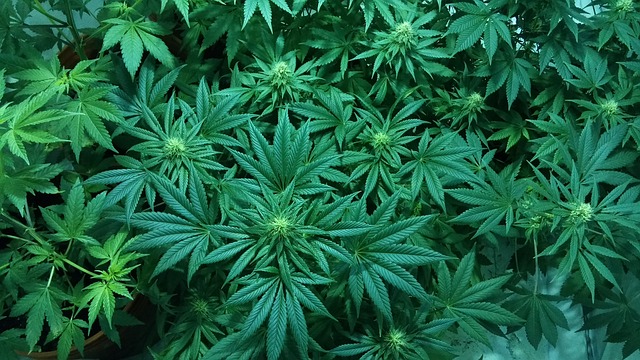The THCA flower, a non-psychoactive component of cannabis plants, exhibits significant therapeutic potential, particularly when combined with CBD and terpenes. This synergistic interaction, known as the entourage effect, amplifies their individual benefits, offering relief from inflammation, pain, and anxiety without intoxication. THCA, which converts to psychoactive THC upon decarboxylation, retains its own set of health advantages even before this transformation. The presence of CBD enhances these effects, and terpenes like myrcene, limonene, and pinene provide additional therapeutic properties. Optimal strain selection and cultivation practices are crucial for maximizing the benefits of THCA while maintaining the integrity of its partners in the entourage effect. This approach to utilizing THCA flower alongside CBD and terpenes is a promising avenue for health and wellness, especially in regulated settings. Understanding the relationship between THCA, THC, and CBD with terpenes is key for consumers seeking informed cannabis and hemp product choices that align with their wellness objectives.
Explore the transformative potential of THCA flower, a non-psychoactive cannabinoid found in hemp and cannabis plants. This article delves into the multifaceted benefits of THCA when synergized with CBD and terpenes, offering insights into its scientific underpinnings, cultivation, and consumption. From understanding how decarboxylation activates THCA to recognizing the importance of terpene profiles for enhanced effects, we explore a comprehensive guide to harnessing the full potential of this natural wellness compound. Join us as we navigate the intricacies of THCA flower, its legal status, and the best practices for preserving its integrity from field to storage. Whether you’re a seasoned user or new to the cannabinoid landscape, this article provides valuable knowledge for anyone interested in the therapeutic applications and future of THCA flower alongside CBD.
- Unlocking THCA Flower's Potential Through CBD Synergy and Terpene Interplay
- The Science Behind THCA and Its Transformation to THC
Unlocking THCA Flower's Potential Through CBD Synergy and Terpene Interplay

Unlocking the therapeutic potential of THCA (Tetrahydrocannabinolic Acid) flower lies at the intersection of cannabinoid chemistry and botanical synergy. THCA, the raw form of THC (Tetrahydrocannabinol), exhibits a unique profile that can be optimized through interaction with other cannabinoids and terpenes found within the cannabis plant. The entourage effect is a phenomenon where CBD (Cannabidiol) synergizes with THCA, enhancing the therapeutic benefits of the latter without the psychoactive effects typically associated with THC. This synergy is not merely additive but multiplicative; it can modulate inflammation, pain, and anxiety responses more effectively than either compound alone. Additionally, terpenes, the aromatic compounds in cannabis, play a pivotal role in this interplay. Myrcene, for example, is known for its sedative properties and can amplify THCA’s analgesic effects when combined. Limonene may brighten mood, while pinene can promote focus and clarity. The careful selection of strain and cultivation conditions to preserve the integrity of both THCA and these terpenes is crucial for harnessing their collective benefits in a legal and regulated setting. By understanding and leveraging CBD synergy with terpenes within THCA flowers, consumers and researchers alike can unlock a broader spectrum of wellness applications.
The Science Behind THCA and Its Transformation to THC

THCA, or tetrahydrocannabinolic acid, is the naturally occurring acid form of THC found in cannabis flowers. It’s a non-psychoactive compound that undergoes decarboxylation—a process where chemical reactions transform it into THC, the primary psychoactive component associated with the cannabis plant. This transformation typically occurs when the flower is heated, such as during smoking, vaporizing, or baking in an edible product. The science behind this conversion is intricate and involves the rearrangement of molecular structures within the cannabinoid’s chemical composition.
The significance of THCA lies not only in its potential to become THC but also in its synergistic effects when combined with other cannabinoids and terpenes found in CBD-dominant hemp strains. These compounds work together through what is known as the ‘entourage effect,’ enhancing the therapeutic benefits of each individual component. For instance, certain terpenes can modulate the psychoactive effects of THC, potentially offering a more balanced and beneficial experience for users. The interaction between THCA, THC, and CBD with these aromatic compounds can lead to a wide array of effects, including pain relief, anti-inflammatory properties, and anxiety reduction. Understanding this interplay is crucial for optimizing the potential therapeutic benefits of cannabis and hemp products, particularly those rich in CBD synergy with terpenes. This knowledge empowers consumers to make informed decisions about the types of cannabis products that best suit their needs and preferences.
In exploring the multifaceted potential of THCA flower, this article has shed light on the transformative effects of CBD synergy and the pivotal role of terpenes in enhancing its properties. The scientific underpinnings revealing how THCA metamorphoses into THC underscore the importance of understanding these compounds for those interested in their therapeutic benefits. As we continue to unravel the intricacies of cannabinoids and terpenes, it becomes evident that a harmonious blend can unlock new avenues for wellness. Users of THCA flower are encouraged to consider the synergistic effects of CBD and terpenes for an optimal experience.
